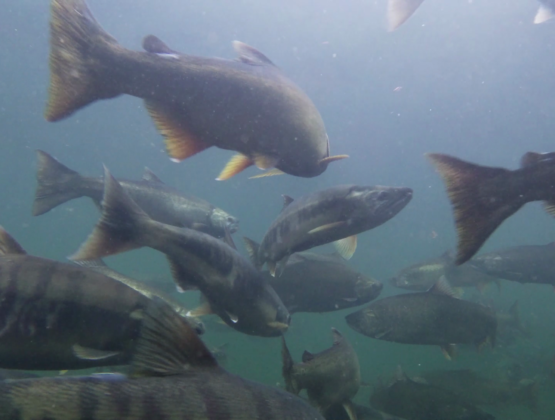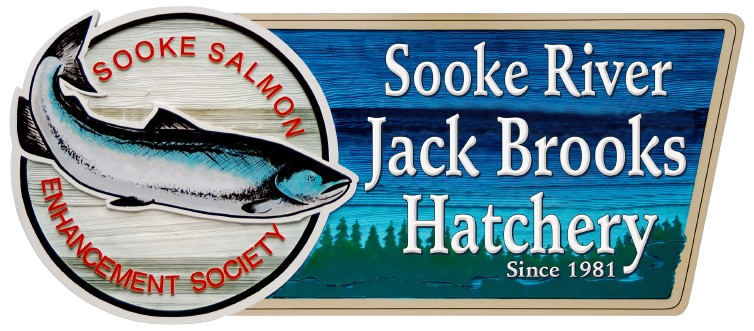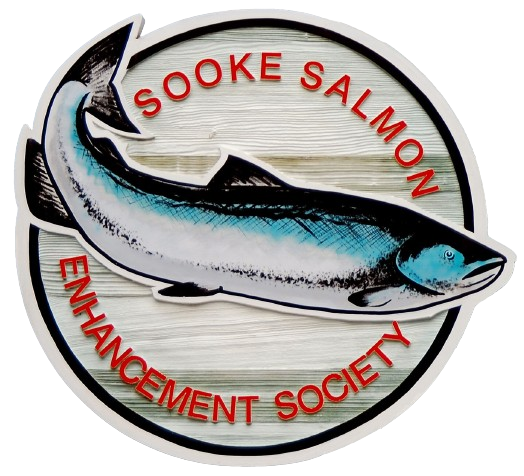
The main activities of the SSES include:
- the operation of the Sooke River Jack Brooks Hatchery which releases 400,000 – 600,000 fry into the local water systems.
- educational activities in schools and the community, focusing on salmon enhancement in the waters of the Sooke River and its tributaries.
- In addition, throughout the summer months, we monitor and maintain the summer flow in DeMamiel Creek, from Bradford Dam to Young Lake to assist in the survival of resident coho and trout during drier summer conditions.
- Beginning in September we install and operate our fence and trap in the Sooke River to capture our returning broodstock.
- In December, we supply eyed eggs for the “Fish in the Classroom” program for the local schools.
- From January to June we do the rearing and daily feeding of the fry until they are released back into the Sooke River and Young Lake.
Yes, we welcome volunteers as members of the SESS. There are currently about 90 individual members of the SESS of all ages.
Volunteer activities include taking the broodstock in the fall, taking and rearing the eggs and alevin, daily feeding of fry, releasing fry into the wild, and hatchery maintenance. Volunteers are also involved in fund raising activities and special events.
No, the hatchery operates entirely with our dedicated volunteers.
Yes you can. Either email or call us to let us know when you would like to visit! A Volunteer will get back to you to schedule a time to visit.
Significant contributions come from corporate sponsors and the federal Department of Fisheries and Oceans (DFO), private donations, and membership dues.
Yes, donations are always welcome. Visit our donate page for more information and to donate!
The Sooke ecosystem supports Coho, Chinook, and Chum salmon, as well as Cutthroat and Steelhead trout. The SSES enhancement efforts are limited to Chinook and Coho salmon.
The numbers fluctuate each year but here are some statistics for you:
- In 2019, the society released 500,000 Chinook fry from the hatchery plus a sea pen release of 75,000. For Coho a total of 136,000 fry were released.
- Historically, including 2019 production, over 20,000,000 fry have been released into the river systems since the inception of the hatchery in 1981.
This is a question and there are many considered opinions on the answer. The experience of Washington State and Oregon is that hatcheries have returned those waters to major economic engines of the Pacific Northwest. Our efforts in Sooke have seen a consistent return to the Sooke river, averaging around 500 adult Chinook each year. With new approaches, better research, we are constantly improving our processes to give the fry we raise the very best chances for survival, in a very big ocean!
Hatcheries are significantly different from fish farms. Unlike fish farms we release fish at the fry stage and they grow to the adult stage in the vast waters of the north Pacific. Fish farms raise their fish to a harvestable size, in an enclosed pen, generally by private enterprise. Some of the fish we raise do return to the Sooke River, but they are also caught by commercial and recreational fishers, seals and sea lions, Orcas, bears, eagles, and a whole vast array of other life forms.
Two ways and counting. The Department of Fisheries and Oceans (DFO) carries out annual fish counts by swimming the waters of the Sooke River in the fall. From DFO’s data, the information provides us with the number of adult Chinook returning to the river each year to spawn.
The other way of measuring success is by determining the number of hatchery raised Chinook returning to the river as adults. This is a new opportunity at the hatchery. We are able to determine this now by using a machine called a chiller. This cooler, by alternating water temperatures, marks a little bone, an otolith, with a unique set of ring patterns, when the salmon are just at the egg stage in the hatchery. Three or four years later, when the adults return to the river, we collect the heads from the captured broodstock and send them away to get the otoliths analyzed. From these results we will find out how many of the returning salmon are from the hatchery. 2023 was the first year we started getting returns at our current hatchery. Stay tuned for the results!
The hatchery is located at 2895B Sooke River Road near the Juan de Fuca Salmon Restoration Society’s Charters River Interpretive Centre.

